Eleven: Football Manager Board Game
- Designer: Thomas Jansen
- Publisher: Portal Games
- Players: 1-4
- Age: 14+
- Time: 90 minutes
- Played with review copy provided by publisher at SPIEL 2022
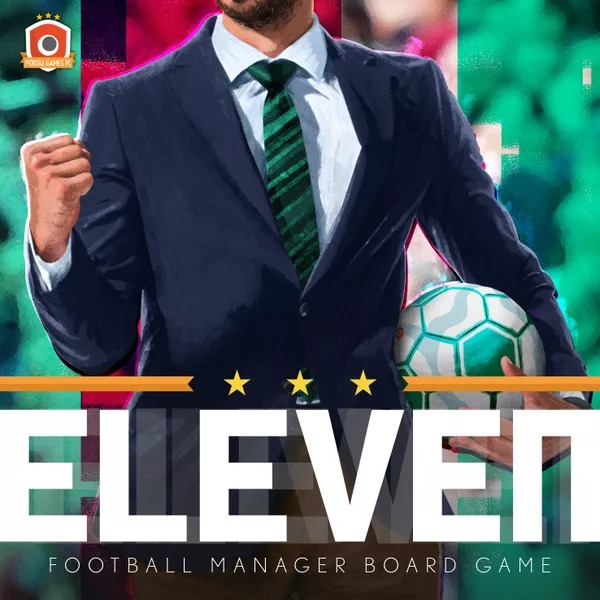
Eleven: Football Manager Board Game is an economic strategy game set in a world of sport. Your task is to manage and grow your own football club over the course of a season. During the game, you hire staff members, including trainers, physical therapists, PR specialists, and directors. You acquire sponsors, expand the stadium infrastructure, and take care of your club’s position in social media. Among the many tasks on the list are transferring new players and choosing the right tactics for each of the upcoming matches.
Eleven can be played multiplayer or solo. The solo mode includes six different scenarios that challenge players with different starting situations and goals for the season. In the beginning, the task is simple: You have to climb the steps of the football leagues and achieve the appropriate experience. You may have to manage the club in a crisis, and at other times you will have to rejuvenate a football team of players that are not so young anymore. You may also have to fight against time to try to complete the stadium before the deadline!
The game finished a very successful Kickstarter campaign last year, and there are already a number of expansions that are available – made due to the response of the KS campaign. This review, however, will focus on only the base game – which has been played both multiplayer and solo here since bringing it home in October.
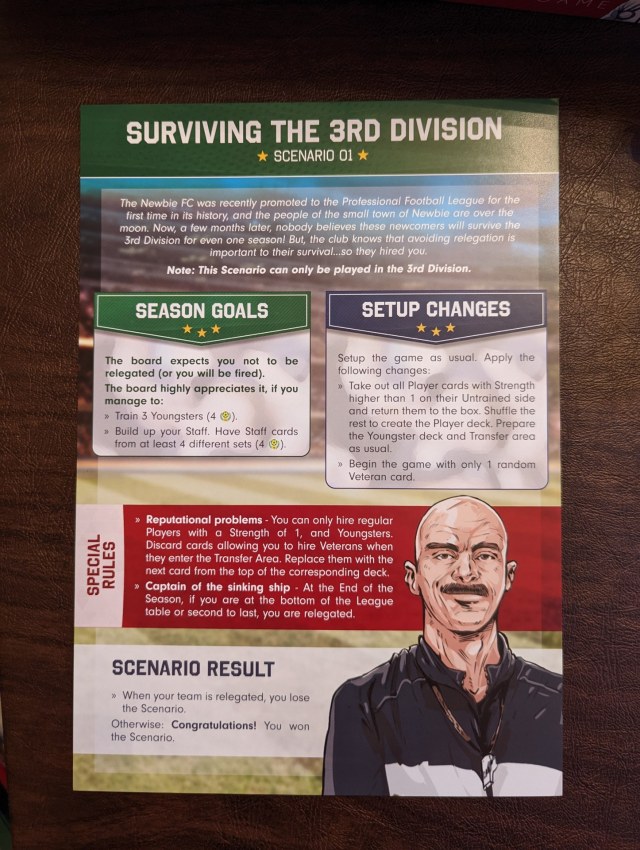
Before I start explaining the game, I think it is important to start out by saying that while the game is very thematic, no previous knowledge of soccer/football is required to play or enjoy the game. The game is very much an economic game by mechanism; and knowledge of actual football tactics and strategy will likely not help you win more matches in the game. In fact, as I’ll outline later, knowledge of how football matches are played may actually be a detriment!

In this game, you take control of a soccer club over a six week season; each week being played over the course of one of the six rounds in the game. To start out the week, you’ll spend three days (turns) taking actions to improve your club – hiring players, improving facilities, employing staff members or seeking out advertising sponsors.
The table is setup to start the game – markets for advertisers, staff members, and regular players are made – 5 cards from each respective deck – it is helpful to separate the rightmost three cards (available now) from the two on the left (coming soon). Each player gets three boards to represent their club (stadium board, club director board, match board). The stadium board starts mostly empty, though a few sponsor spaces are pre-printed filled in on the board. The club manager board is seeded with three directors (they can be distributed in a draft). Each of these cards gives some special abilities as well as a colored dice chart which shows how they will vote on events. Beneath the directors, you will find an area to keep track of your clubs four major statistics: yellow money, red fan support, green staff, and blue fitness. Finally, below the board is an area to keep your staff member cards; all players start with a starting trainer card.
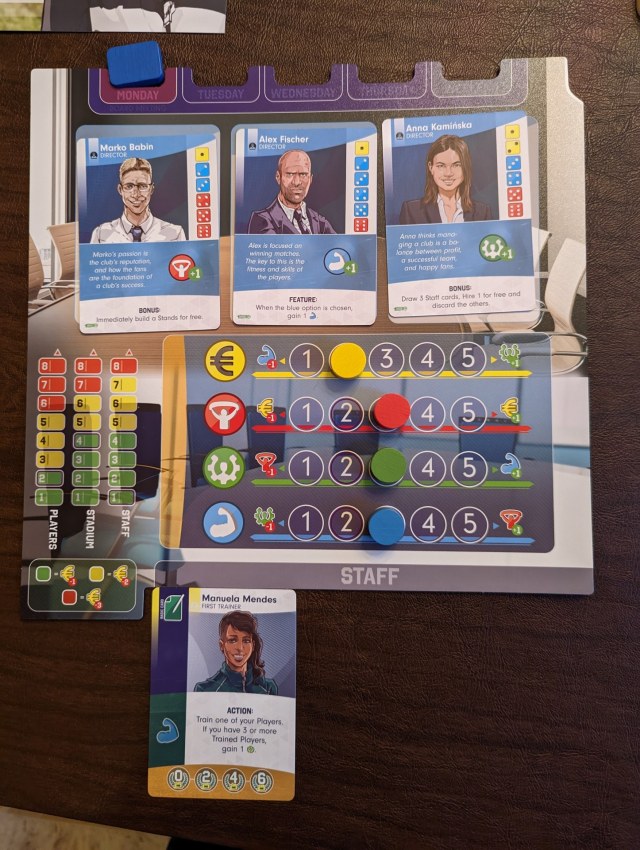
The match board has a schematic of a soccer field on it; you will place ten shirt tokens on the field; the arrangement of these determined by a tactics card (you start the game with one tactics card). Each player is given one Veteran player card and one Youngster card – with an icon on the left side of the card to show you which section of the field they play on as well as whether they are offensive (ball) or defensive (shield) players. Once these are placed; the other positions are filled so that you start with 5 offensive and 5 defensive players. Interestingly, you do not get a goalkeeper to start the game. You will have to acquire one in order to have one on your match board.
Setup is finished by giving each player two objective cards; one of which is kept. This card will provide endgame bonus points. Additionally, the difficulty level of the game is chosen, and each player gets six opponents; one to play each week. The first three being from a slightly easier division than the final three. The League table is set up with all the teams starting at zero points. As the matches occur each week, the markers for each team will be moved along the scoring track here. In each game, there will be 8 neutral teams as well as one marker for each player controlled team. The neutral teams are split up amongst green, red and blue background colors.
So again, once the game is set up – you will play 6 rounds; each one corresponding to a week in the life of your club. In each week, there are 5 turns, the first day being a setup day, the middle three representing a regular weekday and the final turn being the matchday that comes on the weekend.
Monday – Setup day: Players first get production, taking wooden markers matching the stat markers at the bottom of their director board. As you play the game, you will need to be very careful with the iconography. A full colored circle with the resource icon within it means an increase to your statistic while the resource icon alone means the actual resource (wooden disc). The day is finished by having a board meeting. Each player is given an event card at random. There are three options on the card (denoted by yellow, blue or red areas on the card). The player rolls a d6 and then looks at the charts on the side of his director cards. The votes are tallied, and whichever color has the most votes is what happens. If you don’t like the result, you can spend one of your red discs to re-roll the die. This can be done as long as you have red tokens to spend. Apply the results of your event card as directed.
Tuesday to Thursday – Action days. In each of these days, you take a single action (see below). For each day, you can also spend two green discs to take an additional card action. The base action options are:
- Hire a player (or youngster) – hire a player or youngster from the display on the table (youngsters are just from the top of their deck). Cost is 1-4 yellow money discs. You can only buy the three cards from the right of the display. Add the player to the right side of your match board, placing it in the appropriate section of the field. If it is a goalkeeper card, it just goes at the bottom of your board (in the GK area). Now, flip the corresponding jersey marker to the ball/shield side to match your new acquisition.
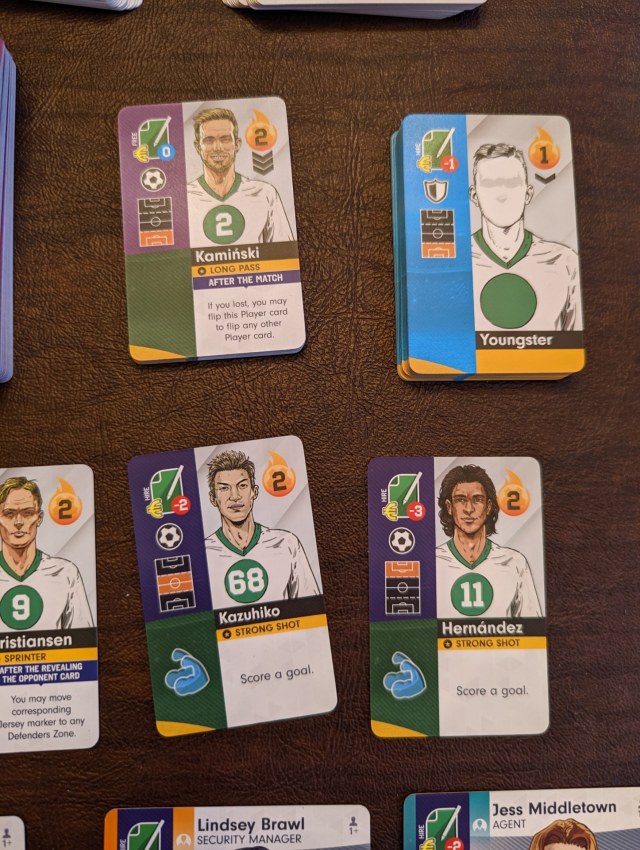
- Sell a player (or youngster) – discard a card you already own, gaining 2 money plus one money per current strength level as well as money for any VP tokens placed on the card. If you are selling a player who is currently hurt or suspended, you only get half of their value.
- Hire Staff – again, you can only take from the rightmost three cards in the display, paying the cost on the card. Add the chosen staff member to your staff area underneath your director board. Some staff members come with actions that activate on purchase (listed as BONUS on the card).
- Contract a Sponsor – you can add sponsors for your shirt logo or onto the adboards in your stadium (assuming you have empty adboards). You can also have one-time media ads. Each of these varieties provides different amounts of money/increase to your money stat/or other special abilities. This is listed on each card. As with the other markets, you are only able to access the rightmost three cards in the display.
- Build Stadium Infrastructure – you can build adboards (to allow for more advertising), stands (to allow more fans) or other improvements which allow for one-time stat advances. You can also build office expansions for endgame points.
- Use a Card action – You can take an action listed on a staff or director card; turn the card 90 degrees to show that it has been used this week.
Weekend – match day! This is a fairly complex day with many steps that I’ll try to condense.

- Prepare – look at the top card of your opponent deck to read the scouting report on the team you are about to play. You can choose from your tactics cards to try to place your shirts in the best formation possible. It is important to remember that you generally don’t change the orientation of your shirts (offense/defense) unless there is a specific action that allows for this. If you want to use some of your purchased player cards, you must place a blue disc on them to include them in the lineup. Otherwise, you will just use a basic generic player for that particular spot in your lineup. Your shirt tokens must be in the portion of the field; with each player card having a specific area. Further, the overall team must fit into the pattern specified by your tactics cards. Within each third of the field, you can choose which shirts are in the center, and you are allowed to place up to one shirt in each wing (outside) area. You can also choose to place one red disc on each of your built fan stands in your stadium. Finally, discard one red card on any player or staff that has one.
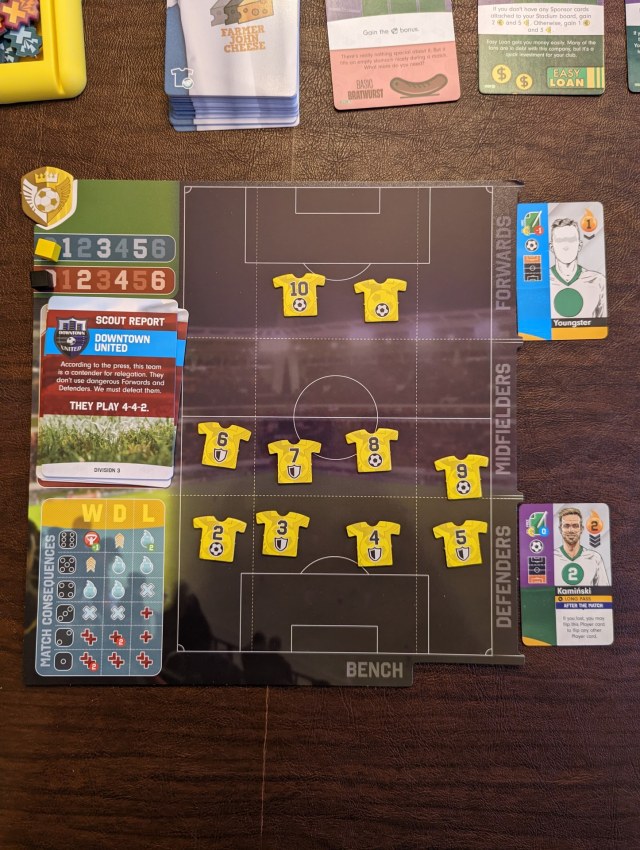
- Now, reveal the back side of the opponent card to see how they line up. You now compare five areas to see who wins the matches (left wing, right wing, and the three central areas). In each area, you compare players. Look at your attacking players and see if they are blocked by an opposing defensive player (who has equal or more skill). If not blocked, a goal is scored – unless the goalkeeper can save it. Now, do the same for the opponents attackers; see if you block them with a defensive player in the same area, and if not, with your goalkeeper. If unblocked – then they score a goal! Do this for all the attacking players in the area, then go onto the next area; repeating until all five areas are scored. The team with the most goals wins! And, since this is soccer, a tie is a possible outcome as well.
- Then, roll a die and consult the chart in the bottom left of the match board to see the post-game effect. Generally, if you win, better things happen than if you lose, and higher numbers are always better than lower numbers. Again, if you have a red disc, you can discard it to re-roll your die
- Finally, update the league table. Each team that won gains 3 points, each team that tied gains 1 point. All other teams move forward according to a die roll (you roll one die for each color, and all teams of that color move equal to the result on their die)
After the match is over, you untap every used card in your area. Then you must pay your maintenance costs – there is a chart in the lower left of your director board. Based on how many players, staff cards and stadium improvements you have, you must pay yellow discs. If you cannot pay enough, you must put red cards on staff cards if you cannot pay upkeep. You keep up to 1 red, blue and green disc between weeks, though you’re allowed to keep all your money. Each of the three card displays is updated by discarding the rightmost card and refilling the display from the deck . The top Youngster card is also discarded. Now play another week…
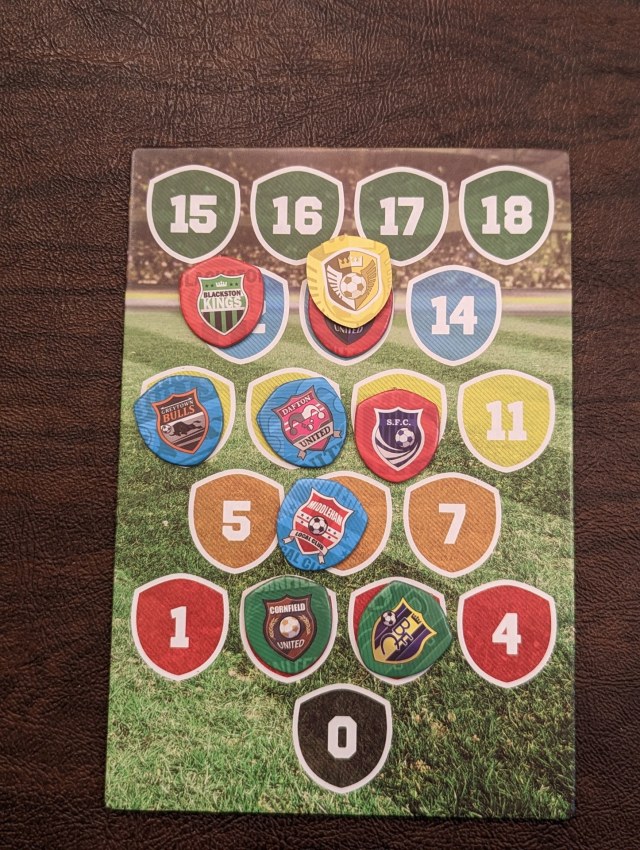
If you’re at the end of the sixth week, then you move to final scoring.
- VP based on standings on league table (from -4VP to +15)
- VP tokens placed on Youngster cards you have played
- VPs for matching types of Staff cards (scoring rubric on bottom of each type of card)
- VPs for stadium improvements
- VPs for Office improvements (0VP to 15VP)
- Lose 1VP for each red card still in your play area.
The player with the highest point total wins. Ties broken in favor of the team higher in the league table.
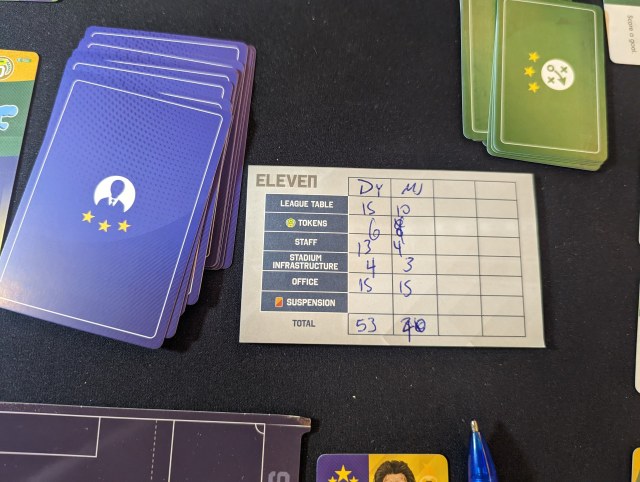
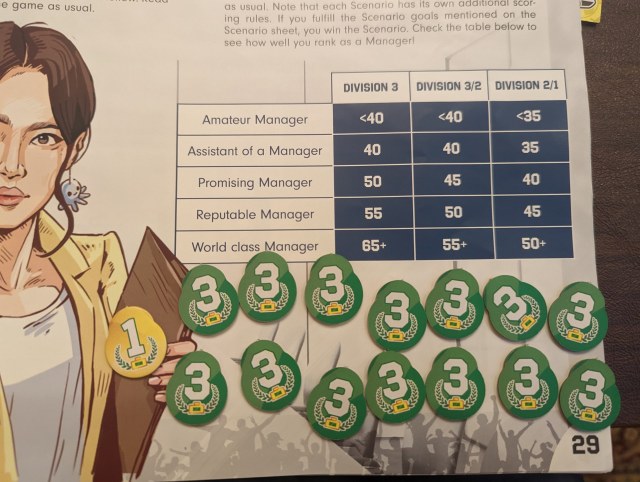
My thoughts on the game
I should start by saying that I’m a huge soccer fan. I’ve spent far too much time trying to find my “perfect” soccer match simulation game; and to date, I haven’t found it. That crazy quest certainly got me very interested and excited about Eleven – but as I mentioned at the start – this is not really a simulation game; it is an economic game about running a soccer club. Yes, there are matches involved in the process of the game, but it is certainly not the focus. In addition, with the unusual timing of the World Cup this winter, I’ve been thinking about soccer pretty much all the time right now…
Despite its length (still about 60-75 minutes for me), this is possibly my most played game since coming home from SPIEL 2022. The competitive game is fun, but it also has a really good solo version where you are faced with challenges on a scenario card. As such, I’ve played this at regular game nights, at weekend cons, and on lonely rainy nights at home by myself; and I’ve truly enjoyed it in all settings.
The game offers you a number of ways to score points; and while you can’t realistically ignore any single facet of the game, I feel like you have the option to concentrate on a number of different strategies to try to push you to the win. The obvious strategy is to field a good team, win matches, and take that highest VP for “winning” the league. However, note that you can score the same number of points by devoting enough resources to upgrade your stadium office to the highest level. So, in this case, Ted Lasso is equivalent to Rebecca Welton. Maxing out the back office with matching staff cards can lead to a double digit score at the end of the game as well. The trick is trying to do as much as you can in the areas that you’re not choosing to focus on at all…
Each week runs pretty smoothly, and by the 2nd or 3rd week of your first game, you should have that sequence down pat. If you need it, the back 3 pages of the rulebook serves as a digest form of the rules for the week; and I’d recommend using this for your first game.
The first game or two can be rough; the rules are a bit herky-jerky so you’ll find that you are looking through the rules for clarifications as you get started. Once you know the game though, it plays quite smoothly. The author is also very active on BGG, and he is pretty quick to answer questions posted there; so if you get stuck on something, the question has likely already been asked by someone and already answered by the designer… But, after that, the rules are easily grokked and you’ll move smoothly through the different steps.
The game, so far, has a lot of legs. In the game, you choose the difficulty by selecting teams from different levels (5 different options, you choose two neighboring levels in each game – thus there are four different difficulty settings). And, if you choose to play solo, even in the base game, there are a number of different scenarios to play through. During the game itself, there are enough cards in the player, staff and director decks to give you lots of different looks as you play through the games. You will run though most of the player and youngster cards each game; but these cards are more about getting used/bought/sold at the right time.
Be warned that the game is a serious tablehog. Each player needs space for three large square boards with some extra space for cards to the side or underneath. Furthermore, the market display can get large as well with three separate five-card markets and the league standing board as well. Heck, the game takes up most of my small table when I’m playing by myself!
After more than a dozen games, I have found a few things which deserve to be mentioned – if only to help others play the game more easily. First, the stat marker icons and the resource icons are…. Not good. The resources are the icon alone while the stat icon is the resource in a solid circle. This can be really confusing at times as the wooden disc used to represent the resource is a round token. It could have been so much less confusing if the player board used squares instead of circles to denote the stat, and then the icon could have been a square as well. Like I said, I feel like I’m a veteran with a lot of game experience, and I still find myself sometimes making an error with these confusing icons.
The rules feel fairly complete, but there are some things which are not clearly spelled out. As I mentioned earlier, there have been plenty of questions asked on BGG (over 120 at the time of this review), and many of them have been answered by the designer. At some point, it would be nice to have a collated FAQ or maybe an updated ruleset put out. The biggest rule that I kept screwing up early on is that you are not allowed to change the side of shirt showing other than purchasing a new player or when an action specifically allows it. I kept trying to put my IRL soccer knowledge into the game, when I should have just been following the rules as written – and in defense of the rules, it tells you explicitly in at least two places that you shouldn’t flip over shirts…
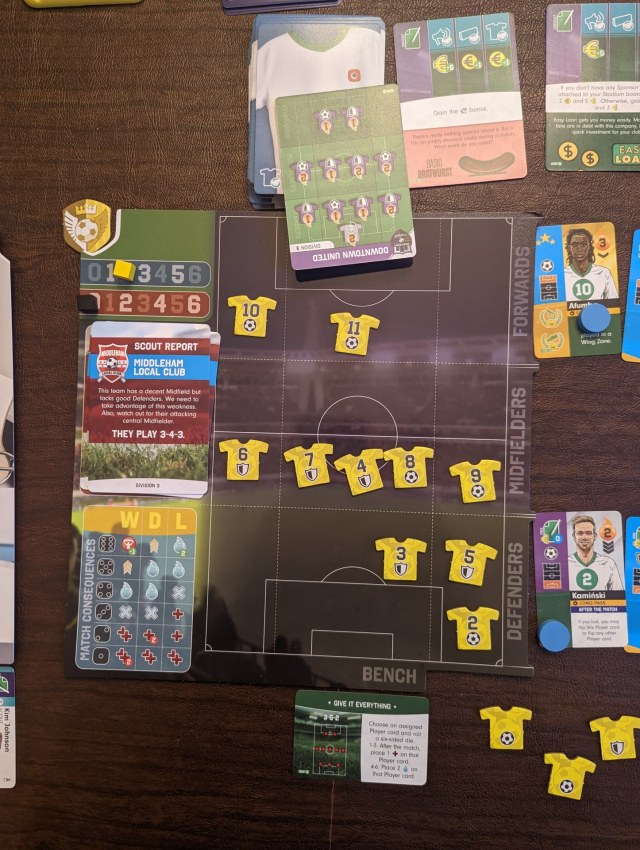
One thing which this shirt rule leads to is a strange imbalance in the matches. In short, I feel that it is extremely beneficial to purchase offensive players to get their shirts flipped over to the ball side. Even if you don’t play those players in a game, you aren’t allowed to change the orientation… so, you start out the game with 5 offense and 5 defense. If you buy two offensive players at the start, you’ll go into the match likely with 7 offense and 3 defense; and ultimately, each unblocked offensive player – even at the weakest basic skill level of 1 – scores a goal. So, if you have an overwhelming majority of attacking players, if you put them in the right places, they can score goals. Does this break the game? Not at all. Especially if everyone knows this about the game to start with. It just, IMHO, increases the value of an offensive player – and players will have to adjust their actions accordingly.
Is the game perfect? No. Actually very far from it. There are a number of rules and component issues that have become apparent. I’m on the fence about trying to devise my own home brew rules for the match resolution phase; though for now, I’m happy to accept that it’s not a realistic soccer simulation, and I’m just working with the rules as the designer has written for now…
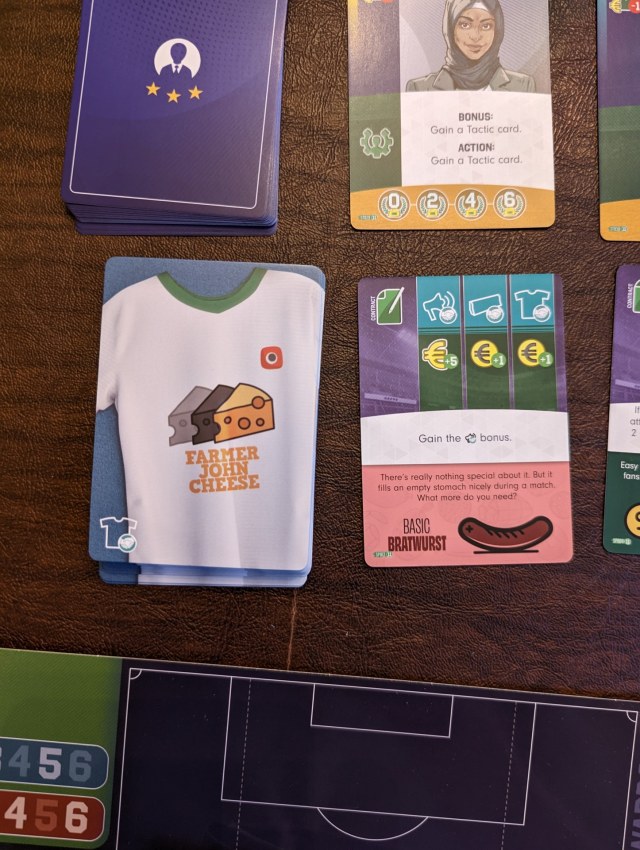
Is it one of my favorite games from SPIEL 2022? Absolutely. I still look forward to playing the game, and I am seriously thinking about investing in some of the five small expansions that will add a new dimension to the game. It’s a game that I think about even after finishing a game – asking myself if I would have done better lining my shirts up in a different formation, or if I had chosen to risk it and re-roll an event die to get a different result.
Eleven is an absolute keeper for me, warts and all. (And I’m hoping for a rules patch down the road that will melt those warts away.) If you’re interested in soccer/football, you owe it to yourself to try the game.
Thoughts from other Opinionated Gamers
Mark Jackson (3 plays with Dale’s copy): I acknowledge all of Dale’s concerns… and echo his praise as well. After playing with his retail copy (2 games vs. Dale, 1 game against the first solo scenario), I am ecstatic that I backed the game with all the goodies (I think the improved components will fix Dale’s issue with the icons). Now I just have to wait for North American delivery.
In case you were wondering, Dale beat me both times. Sigh.
Ratings from the Opinionated Gamers
- I love it. Dale Y, Mark Jackson
- I like it.
- Neutral.
- Not for me…

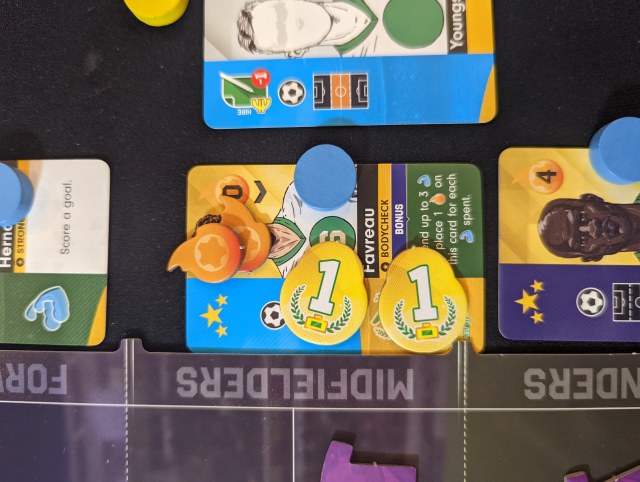
Did I understand correctly that all the matches are against card-driven neutral teams, and not against the other players? If so, doesn’t that feel… weird?
Marcel, i don’t know if weird is the right word… but it’s just the way the game works. The AI teams are tiered into different levels of difficulty, and this gives all the human players a level field each week as they will always be playing teams of equal difficulty; this could not be said if the humans had to play each other.
Also, the game can get a bit wonky as the game even allows two humans to play a game against the same AI team in a given week. We try to discourage this by dealing out the cards to prevent it; but it is something that can happen – and while there are rules to deal with it, it is wonky for sure.
As I said in the review, while the game is about football, it is maybe best to not try to make this into a football sim. It’s not that, and never will be. I’ve learned to enjoy the game for what it is, and not trying to make it fit into the reality of actual club management nor matchday planning.
Hey Dale,
Great write up, mark had had link it up from myspace or such.
Curious if you have any games you would compare it to. I have my kickstarter sitting the shelf unopened and really on the fence about it. Is it something like the networks? i love gil and have spent my entire career in tv and while that game’s theme is well done the pure economics of it weren’t really for me. I feel this might be the same, i do understand it’s not a game of back and forth football, but i’m not quite sure it’s really even about managing a team per se which could be interesting.
Thus would be curious if there are other games or parts of games you might compare it to.
It’s a bit odd to me as more of the youtube reviews/playthroughs i watched or saw were all from people who all literally noted they were not soccer/football fans, and they all had what i would call mixed opinions and no overwhelmingly positive…
cheers
–
James